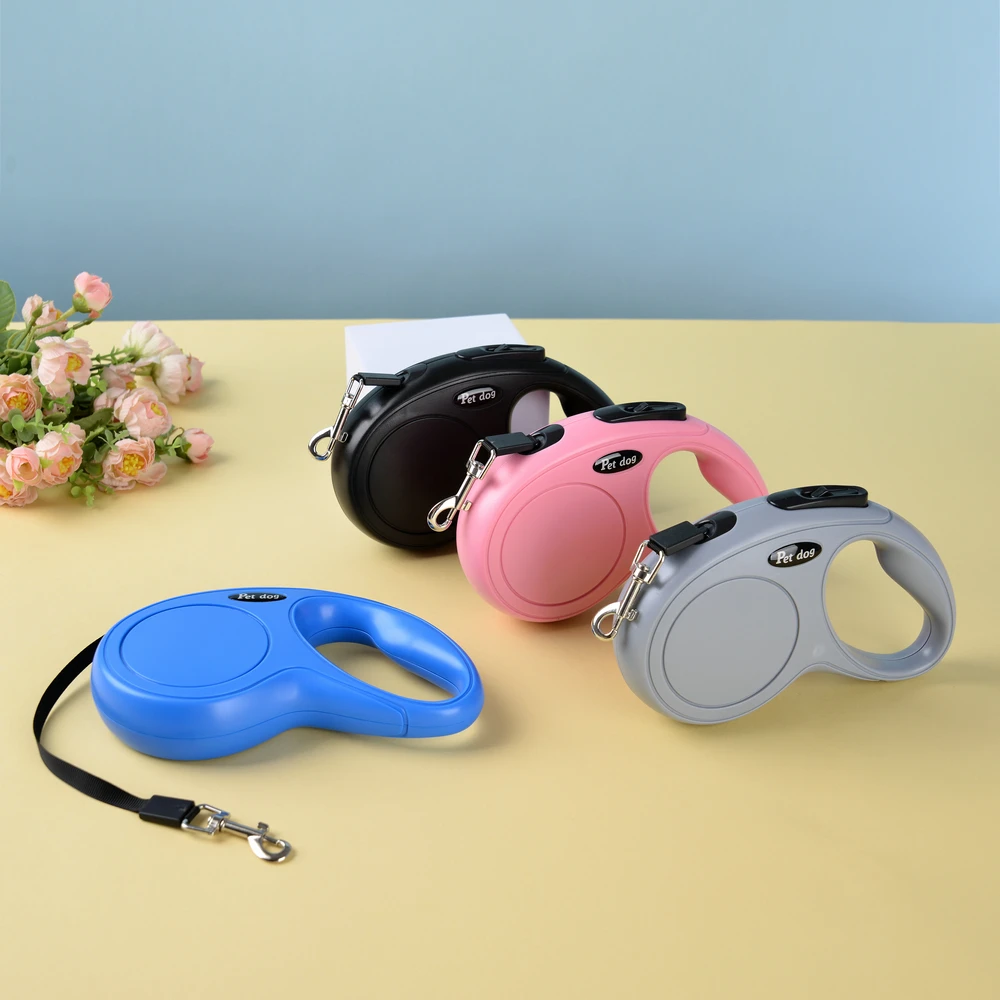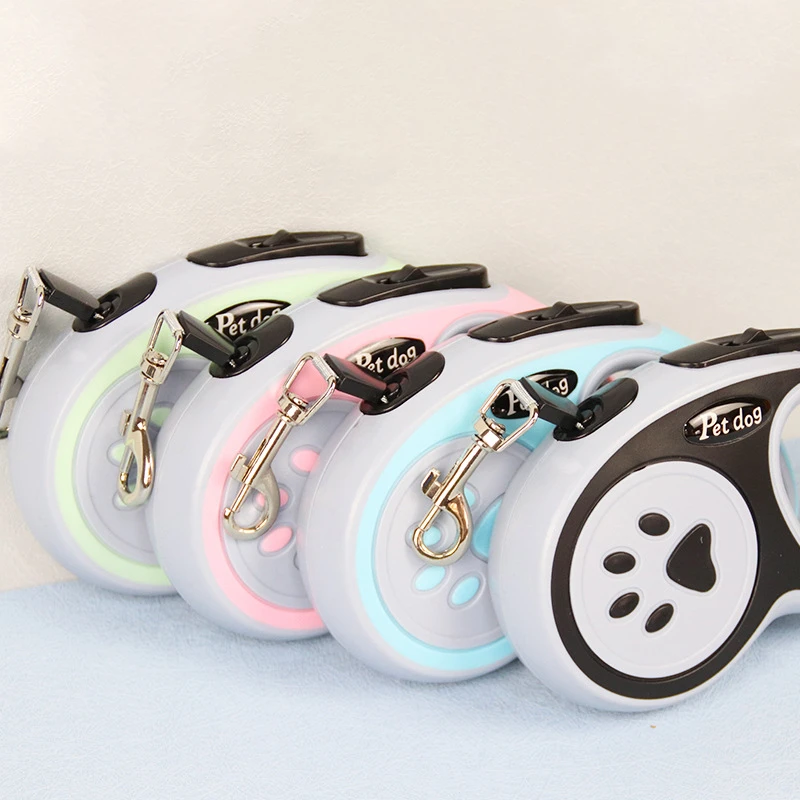Pros of Retractable Leashes
Retractable leashes offer unique advantages for dogs and their owners.
Freedom to Explore
These retractable leashes allow dogs more freedom to sniff and roam when walking.
Dogs can check out new areas, making walks more fun.
Flexibility and Adjustable Length
Retractable leashes can be locked at any length, offering flexibility.
Owners can adjust the leash length to match the walking environment.
Suitable for Training Purposes
Retractable leashes can help in training dogs from a distance.
Commands like ‘come’ and ‘stay’ are easier to teach with these leashes.
The controlled space helps in reinforcing dogs’ obedience.
Convenience for Dog Owners
A simple button lets owners change leash length quickly.
This is handy in varying situations, from open parks to crowded places.
Retractable leashes wind up on their own, making storage effortless.
Cons of Retractable Leashes
While retractable leashes offer advantages, they come with several drawbacks.
Potential for Entanglement and Injuries
These leashes can easily tangle, risking injury to dogs and people alike.
A dog’s sudden movement can cause the thin cord to wrap and cut.
Watch for leash burns or worse when the leash snags on something.
Lack of Immediate Control
A quick response is harder with more leash to reel in.
If your dog charges, a retractable leash won’t stop them quickly.
They offer less control over your dog in unexpected situations.
Safety Concerns in Busy Areas
In crowds, long leashes can trip others or get hooked on objects.
They pose a danger in high-traffic places, to pets and people.
It’s tough to manage a retractable leash among many moving parts.
Sudden Stops and Associated Risks
A fully extended leash can snap back harshly, hurting your dog.
You might get jerked or pulled over if your dog hits the end suddenly.
The sudden stop can injure your dog’s neck or spine.

Tips for Using Retractable Leashes Safely
Retractable leashes can be safe if used the right way. It’s all about choosing the proper leash, training your dog, and being aware of your surroundings.
Choosing the Right Leash
Pick a leash that fits your dog’s size and strength. Look for a tape or ribbon style over thin cords to avoid tangles and cuts. A strong lock feature is essential to control the leash’s length with ease.
Understanding and Training Commands
Training your dog is crucial. Always stay alert and use voice commands like ‘stop’ or ‘come’. Train them to respond even when they roam further away. Practice in a safe space until your dog understands the do’s and don’ts.
Awareness of the Surroundings
Be extra careful in busy areas. Keep the leash short in crowds to avoid trips and tangles. Watch out for dangers like cars, bikes, and other pets. Always pay full attention to your dog and the environment.
Alternatives to Retractable Leashes
While retractable leashes have pros and cons, other options are available. Consider fixed-length and long training leads as alternatives.
Traditional Fixed-Length Dog Leads
These are straightforward and reliable for daily walks. Fixed-length leads give consistent control, making them safer in busy areas. They’re durable, often made of strong materials like nylon or leather.
Traditional leashes come in many styles and lengths. They work well to prevent tangling and injuries. You’re less likely to stumble or trip since the leash won’t extend unexpectedly.
Long Training Leads for Controlled Freedom
Long training leads offer a middle ground. They provide more freedom than fixed-length but without a retraction mechanism. This type of leash suits open spaces and training sessions.
With these leads, dogs can explore yet remain under supervision. They can help with recall training and give a semi-free experience. Simple and long, they don’t tangle like retractables.
Remember, the key is proper use and attention regardless of leash type. Choose one that fits your dog’s size and your activity. Always stay alert and use them responsibly.

Making an Informed Decision
Choosing the right leash for your dog involves careful consideration. It’s not just about preference; it’s about safety, control, and the environment where your dog will be walking. Every dog is different, every setting is unique, and each circumstance may require a different approach.
Evaluating Your Dog’s Needs and Environment
Consider your dog’s behavior, size, strength, and training level. Think about where you’ll be walking: quiet neighborhoods, busy streets, open parks? Assessing these factors helps determine which leash is safest and most effective.
When to Use Each Type of Leash
For well-trained dogs in open areas, retractable leashes might be fine. In busy places, fixed-length leashes provide better control. Long leads can be great for training or more controlled exploration.
The Importance of Responsible Leash Use
Whichever leash you choose, using it responsibly is key. Always stay attentive to your dog and surroundings. Train your dog well and keep public safety in mind during walks. Responsible leash use ensures safety for everyone involved.
Additional Considerations for Choosing a Dog Leash
Types of Leashes and Their Uses
- Standard Leash:
- Material: Often made from nylon or leather.
- Length: Typically 4 to 6 feet.
- Best For: Everyday walks, training, and areas with high foot traffic. Offers good control and is suitable for most dogs.
- Retractable Leash:
- Functionality: Allows dogs to roam further while still being on a leash, with a locking mechanism.
- Best For: Open spaces where dogs can explore safely. However, it may not provide enough control in crowded areas.
- Long Line:
- Length: Can range from 15 to 50 feet.
- Best For: Training and recall exercises in open areas. Provides freedom while allowing you to maintain some control.
- Harnesses with Leashes:
- Benefits: Distributes pressure evenly and prevents pulling.
- Best For: Dogs that pull on the leash or have respiratory issues. Harnesses can be used with standard or retractable leashes.
- Dual Leashes:
- Use: Designed for walking two dogs at once.
- Best For: Multi-dog households, ensuring both dogs are safe and manageable.
Evaluating Specific Situations
- Puppies and Young Dogs:
- Use shorter, more controlled leashes to teach basic commands and leash manners.
- Choose lightweight materials for comfort.
- Reactive or Anxious Dogs:
- A standard leash may provide better control.
- Consider a harness to prevent choking and to help manage anxiety.
- Active Breeds:
- Long lines can be ideal for breeds that require more exercise and mental stimulation.
- Ensure that the environment is safe for off-leash activities.

Maintenance and Safety Tips
- Regular Checks: Inspect your leash regularly for wear and tear. Replace any frayed or damaged leashes to ensure safety.
- Adjust Length: If using adjustable leashes, ensure you know how to quickly and securely change lengths based on your environment.
- Training: Regular leash training can help improve your dog’s behavior on walks, making outings more enjoyable and safe.
Enhancing Your Walking Experience
Socialization and Training Opportunities
Walking your dog is not just about physical exercise; it’s also a prime opportunity for socialization and training. Here are some ways to make the most of your walks:
- Positive Reinforcement:
- Use treats and praise during walks to reinforce good behavior, such as walking calmly beside you or responding to commands.
- Meet and Greet:
- Encourage positive interactions with other dogs and people. Teach your dog how to behave around others, which helps reduce anxiety and reactivity.
- Obstacles and Challenges:
- Incorporate challenges like navigating around benches or curbs. These exercises can improve your dog’s agility and obedience.
- Structured Walks:
- Practice commands like “sit,” “stay,” and “heel” during your walks. This not only reinforces training but also keeps your dog engaged.
Conclusion
Choosing the right leash for your dog involves understanding their needs, behavior, and the environments in which you will be walking. By considering the different types of leashes and their appropriate uses, you can make an informed decision that promotes safety and enjoyment for both you and your dog. Responsible use of the leash plays a vital role in ensuring a pleasant experience during your walks, fostering good habits, and enhancing the bond between you and your furry friend.










